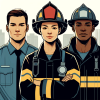If you are preparing for a promotion examination, I am the first to say you must prepare for the position and not for the test. Preparing for the position allows you to be prepared for anything you may get asked during the promotion process.
Below are some basic questions you should ask yourself well in advance of the promotion process. More importantly know the answers to these questions well in advance of the actual moment you sit in the officer’s seat on the engine or truck as a company officer or drive the command vehicle to the incident as a battalion chief.
- Do I know my department’s expectations (SOGs) for every type of incident?
- Do I know my supervisor’s expectations for every type of incident?
- Do my personnel know my expectations for every type of incident?
- What PPE will I direct my personnel (in advance) to wear for different incidents?
- If we are out when dispatched to a response requiring PPE, do I direct the driver to stop to put on our gear or do we do it at the incident?
- What apparatus are dispatched to every type of incident I may have to respond to such as EMS responses, vehicle accidents, structure fire, wildland fires, hazmat and confined space?
- How many personnel are on each of those apparatus?
- What types of resources do neighboring fire departments have to offer via mutual aid?
- How many personnel are on those neighboring resources?
- Do I know what every key is used for on the apparatus key ring?
- Do I know what every radio frequency is used for?
- Do I know the advantages and disadvantages of each radio frequency?
- Do I know how to fully operate each radio on board the apparatus?
- What is the process for requesting mutual aid, and how long does it take to activate?
- What level of resources (additional alarms, mutual aid, etc.) am I able to request?
- What is two in and two out, and how does it differ from the rapid intervention crew?
- When will I establish and not establish two in and two out?
- Who will I use to establish two in and two out?
- How do I let others know that two in and two out is established?
- How will I let the two in and two out out crew know who they are?
- When will I establish RIC and with whom?
- If I am assigned as the RIC group supervisor, what tools and equipment will I direct my personnel to cache?
- Can someone realistically survive the current environment — meaning is it worth attempting a rescue or will it be a body recovery?
- Where will I place my first, second and third hose lines?
- What is my trigger point to have a crew drop a supply line?
- What is my trigger point to have the supply line charged?
- What is my trigger point to request a second alarm, third alarm, strike teams and task forces?
- Where will the fire be when water starts flowing, as opposed to where the fire is right now?
- How will I use each person on each apparatus?
- When will I use 1½-inch, 1 3/4-inch, 2 ½-inch and master-stream hose lines?
- If I have to break up crews, which rigs can I break up?
- Which incident command system positions will I typically fill and with whom?
- Do I know the steps to take if given a firefighter down, missing or trapped situation?
- If my department uses volunteers or reserves, how will I use them?
- Do I know the 10 standard fire orders and the 18 situations that shout: “watch out?”
- Do I understand OSHA regulations and NFPA standards (especially 1500)?
Take these as a starting point. If you can honestly answer them before having to manage an incident during your next promotion examination or more importantly, during your next incident you respond to as a company officer or chief officer, you will find yourself more prepared than you were yesterday.
Remember, our job is to not leave the scene any worse than we found it. Obviously, that is sometimes out of our control, but do it when possible, within reason.
Do what you can to prepare for the incident before you have to manage it and you will be successful.


